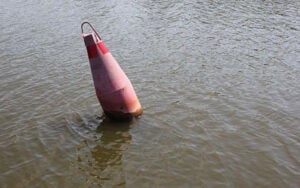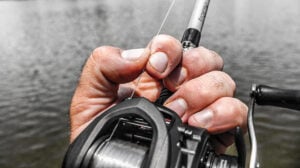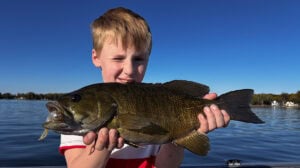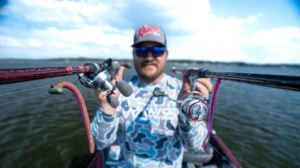Bass fishing in current can be very fruitful but it poses unique challenges. While moving water can certainly position bass in predictable locations, effectively presenting your bait involves a lot of trial and error and continuous experimentation.
This past weekend I fished a tournament on my home lake that forced me to “fish the moment” and venture outside of my comfort zone. Georgia Power usually generates current overnight, but the recent heavy rainfall had the floodgates wide-open for much of the day. With a wad of fish located on a river ledge and no backup plan, I had no choice but to learn to effectively fish heavy current in a matter of hours.
I didn’t break any world records Saturday, but my partner and I had a very strong showing. After the tournament, I made this list of simple, yet very helpful lessons I’ve learned about fishing strong current in hopes it would help you as well.
Avoid round jigheads
For whatever reason, when many anglers fish with weighted soft plastic rigs, only two possibilities are often considered—a bullet-shaped Texas rig weight or a round jighead. I’ve quickly learned that these two styles, while effective in other situations, are not ideal when you’re faced with heavy current.
I started the day with a round 1/4-ounce jighead and had nothing but problems. After making a long cast up-current, I’d have about six seconds to present my worm before the current washed it to the back of my boat. No matter the casting angle or the speed at which I worked the jighead, I couldn’t keep my bait in the strike zone long enough—until I made an important realization.
When the current is ripping and you’re trying to target deep fish, avoid using round jigheads. Regardless of its weight, a round jighead is prone to tumbling with the current. On every cast I could feel my shaky head rolling across rocks, which was not only unnatural, but also resulted in a bunch of hang-ups.
Instead, consider using a football-shaped head or some sort of head with a flat surface. I switched to a VMC Rugby Jig and Buckeye Pro Model Spot Remover and noticed an immediate improvement. These head shapes were very stable in the current and stayed in place much better than my previous round jighead. They didn’t roll or tumble and allowed me to take my time while carefully presenting my offering to the wary, post-frontal bass.
If you’re used to fishing with regular round-shaped shaky heads, this combination may look a bit strange, but try to remember—you’re not going to catch fish if you can’t keep your bait where they live.
Keep your rod tip low
We’re always taught to keep our rod tips on the high-side when working a jig or weighted soft plastic, but a high rod tip can cause multiple issues in areas with current.
When your rod tip is high, you’re putting more line between your rod tip and the water. This leads to a major problem that results in a significant decrease in sensitivity—line bow. When the current bows your line to the side, your ability to detect bites will be greatly hindered. Throughout the winter months, even the biggest bass may not crush your bait so maintaining the ability to feel even the softest, most subtle bite is an absolute must
A low rod tip will also help you keep contact with the bottom. You’ll be able to feel very small but important transitions in bottom composition whether it’s a shell bed, a change in rock size or a fallen tree that has been washed against a steep bank. If the current is especially heavy, don’t be afraid to put your rod tip right above the water’s surface. It may look like you’re dragging a Carolina rig but you’ll have a much better feel of what’s going on down there.
Focus on the down-current side
Current eddies aren’t always easy to see, making it important to visualize the current’s effect on cover and structure
Current eddies aren’t always as obvious as one would think. It’s tempting to think of them as huge, slick areas of water, but they’re often very subtle and difficult to see from the surface.
When you’re breaking down an area with current, try not to overcomplicate things. Bass are opportunistic feeders and make a concerted effort to use as little energy as possible when feeding—just like one of us sitting close to a restaurant buffet.
For this reason, they will often position themselves on the down-current side of a piece of cover such as a tree, stump or rock pile and face into the current. This allows them to hang out and relax in slack water, waiting for an easy meal to pass by.
So if you’re looking at a piece of cover and the current is coming from the left—make a few casts to the right side of the cover and vice-versa. It’s not overly complicated, but it’s one of those aspects of bass fishing that we’re all guilty of overlooking periodically.
Cast into the current
This past weekend I was concentrating my efforts on a 30-foot deep river ledge that was absolutely loaded with bass. If I were to cast perpendicularly to it, my bait would barely touch the bottom before the current got ahold of it. Whenever I made a cast down-current, I had a hard time controlling my boat speed and I’d wind up on top of it. Once I started casting up-current, I started catching a bunch of fish.
Like we just discussed, casting into the current makes a lot of sense because of a bass’ preference to position itself facing into the current. But it’s also very important to consider your boat positioning and control.
When you point the nose of your boat into the current and cast directly ahead, you’re able to control your boat very easily. By keeping a steady foot on your trolling motor, you can make small adjustments and avoid being washed backwards by the current. Whenever you turn your boat perpendicular to or away from the current, you give the current a lot more “boat” to hit, resulting in constant readjustments and poor casting angles.
By pointing my boat into the current, keeping my MotorGuide on a constant 6-speed setting and making casts up-river, I was able to precisely target small intricacies on the river ledge and present my bait naturally.
Check out this video of Jonathan Newton catching a big smallmouth in a tailrace area.
Stay in constant contact with your line
This not only applies to current fishing, but all types of finesse fishing with spinning gear. Throughout my guiding career, teaching new anglers how to detect bites is, by far, the most difficult aspect. If you’re relying solely on your rod tip to detect bites, you won’t catch as many fish. It sounds harsh, but it’s the truth—especially when you throw a bunch of current in the mix.
There’s a really simple way to feel more bites, however. Keep the index finger of your rod-hand—whichever hand you hold the rod with—on your tight fishing line any time you’re not reeling. This gives you direct contact with your bait without the rod tip absorbing any energy from the initial bite. Whether you’re battling current, wind or both, you’ll be amazed how much this increases your sensitivity.
Expect hang-ups
We all have that fishing buddy who absolutely loses their mind whenever they get hung. Fishing tackle gets expensive, so I can certainly understand the frustration.
Unfortunately, hang-ups are inevitable when you’re bass fishing in current. Even with the right jighead, rod angle, casting angle and presentation, you can fully expect some snags. Instead of losing your cool, cinching down your drag and trying to break your line, relax—you can probably get it back.
Most of your current-oriented hang-ups are due to the bait washing into small crevices such as rock cracks or splits in wood cover. When this happens, don’t start snatching. Simply go up-current from your bait, keep steady tension and more times than not, you’ll get your gear back. As long as your hook doesn’t penetrate into the cover, you should be good to go.
The next time you bass fish in current, keep these tips in mind. They’re very easy to execute and if you can slow down, think things through and develop a deliberate approach, you’ll be able to use the current to your advantage this year.
Do you have any other tips for finesse fishing in current?













